How do you know if your social strategy is working? Is an average of 15 comments per post a win, or is it just average? And when is the best time to publish your content?
There is no universal answer — it all depends on factors like your sector, the platforms you’re using, your audience demographics, and more.
That’s where social media benchmarks come in. These numbers offer a clear view of what’s normal for your industry in terms of engagement and growth, helping you understand how your results compare.
Read on for the most recent social media benchmarks and stats specific to the government sector that will put your performance into perspective. In this post, we break down the most recent available data (collected in Q1 of 2025).
Psst: Once you grab your benchmarks, head to our guide to using social media for citizen engagement to find out how to action these insights.
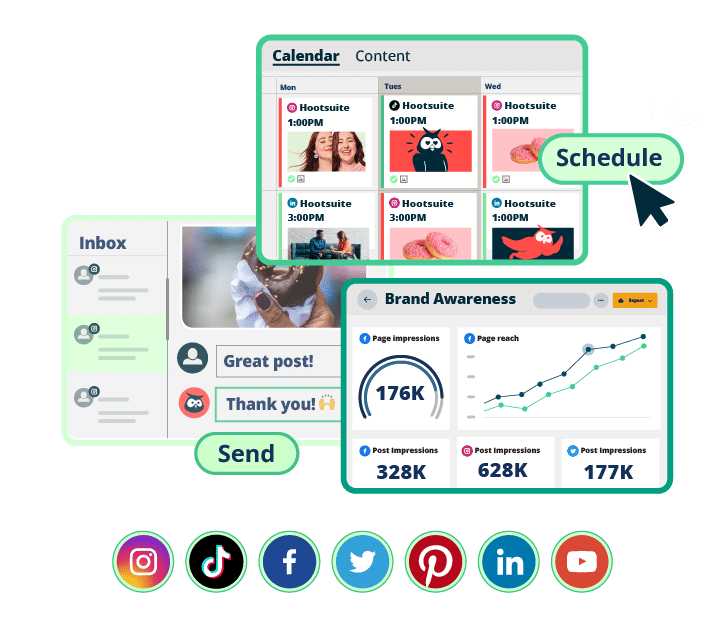
Engage citizens with the only tool that makes it easy to communicate, deliver services, and manage crises.
Book a DemoBelow, you’ll find recommendations for the best times to post on Instagram, Instagram Reels, Facebook, TikTok, LinkedIn, and X (formerly Twitter) for maximum engagement.
Note: Time of day was localized across 118 countries where sample data came from, i.e. the graphs are accurate across time zones.
Best time to post on Instagram
According to our research, Instagram engagement is highest between 6 and 8 pm throughout the week for government organizations.

Best time to post Instagram Reels
Mid-day is generally the best time to post on LinkedIn in government.
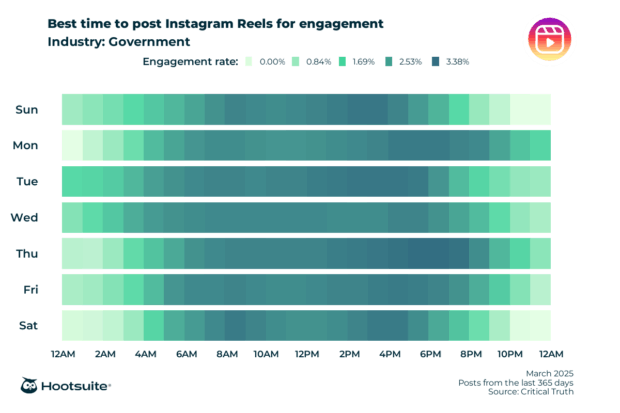
Best time to post on Facebook
Content posted on Thursday and Friday between 6 and 8 pm tends to do particularly well on Facebook.
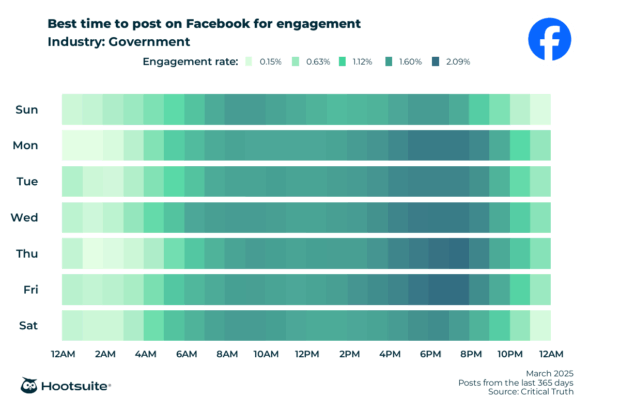
Best time to post on TikTok
The best times to post on TikTok for government institutions are:
- 12 pm on Mondays
- 6 pm on Fridays
- 1 pm on Saturdays

Best time to post on LinkedIn
Posts published between 5 and 8 pm on Wednesday seem to generate the highest engagement on LinkedIn.

Best time to post on X (Twitter)
The best times to post on X for government institutions are:
- 12 pm on Mondays
- 1 pm on Tuesdays
- 10 am on Wednesdays and Thursdays

Every government agency and official’s ideal posting schedule is unique, and you should test different posting frequencies to find out what works best for your audience. That said, these industry-specific stats will help you find a data-informed starting point.
Our research found that in Q1 of 2025, government institutions posted on Facebook more often than on other social platforms — an average of over 16 times a week. TikTok sits on the opposite side of the scale with under 2 weekly uploads.
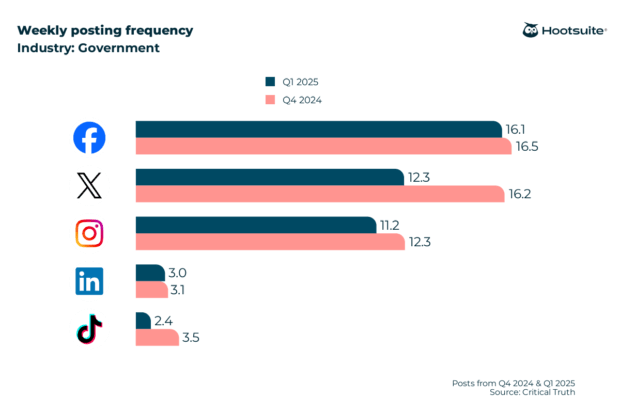
Below, you’ll find network-specific data that illustrates how posting frequency corresponds to overall engagement rates.

On Facebook, performance depends on the content you post more than it does on how often you post. However, institutions that posted 2 times a week see the most amount of engagement at 2.32%.

The same goes for Instagram. Organizations that posted twice a week registered the most engagement a week at 4.21%.

On LinkedIn, 3 posts a week were the sweet spot for engagement in Q1 of 2025.

On X (Twitter), 2 posts per week garner the most engagement at 2.03%
Average engagement rates in government
Wondering if your engagement rates are high enough? Here are the industry averages across all major social networks as of March 2025:
- Instagram: 3.5%
- LinkedIn: 2.7%
- Instagram Reels: 2.6%
- Facebook: 2.5%
- X (Twitter): 1.7%
- TikTok: 1.6%

Different social networks offer different content formats — but how do you decide which should dominate your content mix?
Here’s what our research says.

On Facebook, album posts generated the most engagement — followed by status updates, posts with links, videos, and individual photos.

Instagram users were most likely to interact with carousels, followed by regular photo posts.

On LinkedIn, posts with photos outperformed posts with links.

On TikTok, videos reign supreme, generating the most engagement.
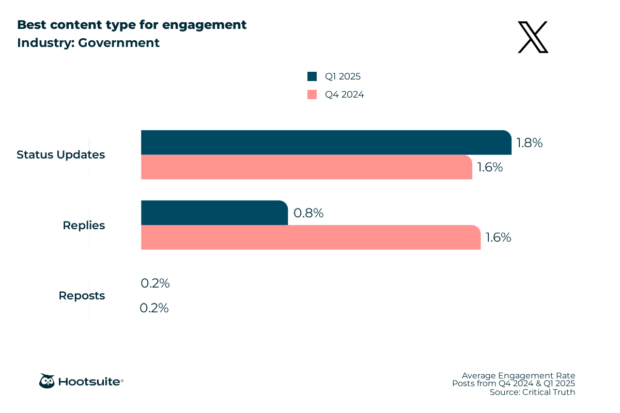
Over on X (Twitter) status updates carry more weight (1.8% engagement) than replies (0.8% engagement).
Follower growth rate in the government sector
If your social media strategy revolves around growing your audience, make sure you’re setting realistic goals. Here is how other government profiles did in Q1 2025:
- TikTok: 0.7%
- Instagram: 2.17%
- Facebook: 1.38%
- LinkedIn: 0.39%
- X (Twitter): 0%

Inform and engage on social media with Hootsuite. From a single dashboard, you can schedule and publish content to every network, monitor relevant conversations, and measure public sentiment around programs and policies with real-time social listening and analytics. See it in action.





![Social Media Benchmarks Q2 2024 [Data & Tips]](https://blog.hootsuite.com/wp-content/uploads/2024/09/Social-media-benchmarks-Q4-2024-data-tips-time-to-post-on-social-media-Q3-2024-data-556x556.png)

